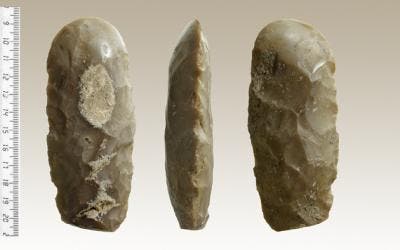During the Neolithic period, man made the big jump from hunter-gatherer to farmer and agriculturalist, eventually moving on to larger and larger settlements, with a variety of animals and plants. The transition also brought significant changes in terms of economy, architecture, and apparently, woodworking.
Dr. Ran Barkai of Tel Aviv University‘s Department of Archaeology and Ancient Near Eastern Civilizations has shed some new light on human evolution during that period, demonstrating a direct connection between the development of an agricultural society and woodworking tools.
“Intensive woodworking and tree-felling was a phenomenon that only appeared with the onset of the major changes in human life, including the transition to agriculture and permanent villages,” says Dr. Barkai, whose research was published in the journal PLoS One.
Prior to the Neolithic, there is no evidence that tools were strong enough to carve wood – let alone cut trees. But new archaeological evidence suggests that as the period progressed, lumberjacking and wood carpentry developed side by side agriculture. The use of functional woodworking tools in the Neolithic has never been studied until now, and through this study, archaeologists unearthed evidence of unexpected carpentry sophistication.

The early part of the Neolithic is split into two distinct periods: Pre-Pottery Neolithic A (PPNA) and Pre-Pottery Neolithic B (PPNB). Agriculture and domesticated animals appear only in PPNB, so the transition is a really important moment in human history. However, in PPNA, humans remained hunter gatherers, but they started settling into more permanent settlements for the first time. Axes associated with this period are smaller and more delicate, used for light carpentry but not cutting down trees. In PPNB, the tools evolved, not only in terms of sophistication, but also in terms of size, becoming heavy and powerful enough to cut trees and complete various building projects.
“We can document step by step the transition from the absence of woodworking tools, to delicate woodworking tools, to heavier woodworking tools,” Dr. Barkai says, and this follows the “actual transition from the hunter-gatherer lifestyle to agriculture.”
He also identifies a trial-and-error phase during which people were trying to develop a large enough axe for the task. This was extremely important, because it allowed a new architecture to emerge, one strong enough to support the adjustment to a permanent settlement. Not only were people settling in villages, but their houses were taking different shapes – literally. The round and oval structures of earlier domiciles were replaced by rectangular structures in PPNB, explains Dr. Barkai.
“Evidence tells that us that for each home, approximately 10 wooden beams were needed. Prior to this, there were no homes with wooden beams.”
They were also able to create buildings pens and fences for domesticated animals, which was also an important step towards settling down. So in a way, something seemingly as unimportant as developing axes allowed permanent settlements to develop, leading to growing comfort and villages.
Journal reference: PLoS ONE






